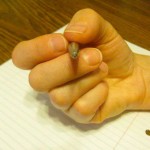How to Practice Cursive Penmanship
by Owen Fourie
Cursive handwriting and the use of laptops should each have a role in education. One should not be regarded as being in opposition to the other.
In the first part of this article, we considered the value of cursive penmanship and its actual and potential benefits. In this part, we’ll look at the practice of this skill.
How to sit to write comfortably and correctly
- The student needs to sit squarely facing the desk or writing table;
- The feet should either be flat on the floor or crossed but still on the floor. The legs must never be crossed;
- The upper body must be kept in a naturally erect and relaxed position. There must be no bending over the work;
- The paper must be placed at an angle, tilted slightly in a counter-clockwise direction. The right arm needs to meet the bottom edge of the paper perpendicularly;
- The elbow acts as a pivot. When the arm is moved from left to right, the hand is able to make an arc on the paper from one edge to the other;
- The left arm is allowed to rest on the table while securing the writing paper near the top left.
How to hold the pen or pencil
For proof that cursive writing has not been properly taught for many decades, do this: take care to practice the one correct way to hold a writing instrument—the way it has been done for centuries—and then observe how most adults and children hold a pen today. Here is the correct method if you are right-handed:
- Hold your pen (or pencil) about an inch (2.54 centimeters) above its tip;
- Let the first joint of your middle finger support your pen from the bottom;
- Let your thumb hold it from the left;
- Let your index finger hold it from the top right;
- Test this grip, which is firm but relaxed, by turning your hand and pointing the writing tip directly towards you. If you are holding your pen correctly, you will see it emerging from a triangle formed by your three fingers;
- Let the upper part of the pen rest in the cradle formed by your thumb and index finger;
- Let your fourth and fifth fingers curl naturally, slightly towards your palm. They are supporting your writing fingers together with the rest of your hand as it touches the writing surface. These fingers and the rest of your hand help the movement across the paper.
If you are left-handed
- Follow the same directions given above for a comfortable and correct position when sitting at the writing table. As a left-handed writer, you need to make only two changes to these directions:
- Place the paper at a greater angle than for a right-handed person, but tilt it in a clockwise direction. (As with the right arm, the left arm needs to meet the bottom edge of the paper perpendicularly.);
- Let the right hand secure the writing paper at the top right.
- Follow the same directions given above for holding your pen correctly. Simply apply these directions to your left hand and make these changes:
- Hold your pen (or pencil) about one and three-eighths inches (about 3.5 centimeters) above its tip. Obviously, your thumb will hold your pen from the right while your index finger will hold it from the top left;
- Let the top of your pen point towards your left shoulder;
- Keep your left hand below the writing line to avoid the “hooked” position commonly adopted by left-handers who have not been taught correctly;
- Use the same forward slant that is characteristic of cursive penmanship.
A Lesson from The King’s Speech
In the film The King’s Speech, speech therapist Lionel Logue helps Prince Albert (later, King George VI) to deal with his stammering. Logue learns from the prince that he was forced to abandon his natural inclination to use his left hand.
He was compelled to use his right hand at about the age of four or five, and it was at that age that he began to stutter.
It has been observed that forcing a left-handed person to use the right hand for tasks such as writing might result in some incoordination and speech problems.
Resources
Practice cursive:
- For lower case letters: http://www.linguanaut.com/cursive_alphabet.htm
- For upper case letters: http://www.linguanaut.com/cursive_alphabet2.htm
Blumenfeld, Samuel L. How to Tutor. Boise, Idaho: Paradigm, 1973. Print. This book contains an excellent practical section on cursive handwriting.
How to Improve Handwriting—nine short video demonstrations by Nan Jay Barchowsky. This is not strictly cursive, but there are many points that can help your handwriting:
http://www.monkeysee.com/play/9112-how-to-improve-handwriting
Teaching Left-Handers to Write:
—–
If you use cursive writing, what are your personal experiences of its benefits? Your comments, observations, and questions are welcome.
Here are articles to help you with English words, grammar, and essay writing.
Copyright © 2011 by English Essay Writing Tips www.englishessaywritingtips.com


